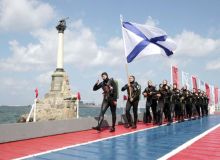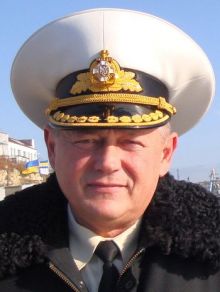During the Cold War a Soviet naval task force in the Mediterranean was deployed in the face of the US Sixth Fleet. The Soviets spared no funds to demonstrate their military presence, until 1992 when there turned out to be no funds left and none to be expected. The steel warships were old, in dire need of repair, so they had to leave the Mediterranean. The same happened in Cuba and at the Vietnamese naval base of Kamran.
After sharply increasing oil and gas prices the Russian central budget received such funds and the good old imperial complex once again became the idee fixe of Russia’s ruling class. No better way to show that one was back on one’s feet than sending warships overseas. Terribly expensive, but the end seemed to justify the means, showing the world the grandeur – however illusory – of the Russian state. One is reminded of Francoise Sagan’s La Chamade and its heroine saying that one has to pay dearly for one’s proud posture.
During an extended meeting at Russia’s Ministry of Defense, Minister Sergey Shoigu said a decision had been made to deploy a permanent naval task force in the Mediterranean: “I believe that we have every opportunity to form this task force and ensure its effective operation. Such a task force is capable of carrying out missions in remote sea areas.”
Russian warships will be deployed in this strategic region on a permanent basis. According to the defense ministry, the Mediterranean is where Russia faces the main threats to its national security.
Russia’s largest naval exercises in its post-Soviet history recently ended in the Mediterranean and the Black Sea, with two large landing ships visiting the Syrian port of Tartus. The exercises involved warships of all of Russia’s four fleets.
Interestingly, two-thirds of the Mediterranean task force will consist of warships of the Northern Fleet and one-third of the Black Sea Fleet, with operational command onboard the flagship.
Perhaps such long-range voyages from the naval bases at the Kola Peninsula, round the European coast, make sense in terms of combat training, but let’s take a look at the whole thing from another angle.
The Mediterranean task force will be made up of ten warships: six to seven ones from the Northern Fleet and three to four from the Black Sea Fleet. Doubtlessly a formidable military force, strong enough to challenge the US, Turkish, and other NATO fleets. On the other hand, the Northern and Black Sea fleets do not have enough combat vessels to be deployed in the Mediterranean on a permanent basis. Also, water and fuel supplies will require visiting Montenegrin, Cyprian and possibly Greek seaports. Another heavy budget spending.
Warships on such a mission can’t stay at anchor and every voyage shortens the ship’s service life which isn’t very long anyway, considering that Russia’s warships were built a long time ago. According to Admiral Viktor Kravchenko, ex-Chief of Naval Staff, Russia does not have the capability to create a permanent task force in the Mediterranean. It lacks combat-ready vessels and reliable logistical support: “I don’t know why all this talk about a Mediterranean squadron. Another piece of rhetoric and wishful thinking. Should a task force be formed using what’s left of the fleet, the ships would exhaust their motor potential during the year and have to undergo repair.”
In a way the admiral is echoed by Defense Minister Sergey Shoigu who said: “The overall situation with the Navy cannot be described as satisfactory, primarily because no new ships have been added to the fleet for a long time and maintenance terms and conditions have not been observed. As a result… a number of vessels have restrictions on the use of weapons and military equipment.”
Then why waste so much money on this task force venture?
The reason is not only Russia’s longing for its past might and glory, its burning desire to prove something to somebody. NATO countries know the cost of such task forces only too well.
Factor number one is domestic. The propaganda part of the whole affair is clear: vex your haughty neighbor (there is little with which to vex the close and remote neighbors that aren’t easily bullied, but the Russian public doesn’t have to know about such aspects). [Moscow’s] Channel One and NTV will play [appropriately inspiring] videos and that will do.
However, there is another, considerably more weighty, domestic factor. Overseas deployment calls for upgraded equipment, materiel, sea- and aircraft. A navy without air support is practically useless. Russia suddenly showed a strategic interest in Vietnam and Latin America (after what has happened in Venezuela the course events will take there is anyone’s guess, and the same is true of the Mediterranean). How can one discuss Syria without sending two landing ships to Tartus?
This is something the military-industrial complex is looking forward to: re-equipment and upgrading, construction of warships, repair – all that which calls for heavy budget spending. A long-cherished dream of those in charge of the complex and generals and admirals involved. If funds start flowing in, like in the good old Soviet times, the current regime will receive a firm footing. That’s what the whole thing is all about.
The last but not least factor has a bearing on Ukraine. The Black Sea Fleet at Sevastopol will take part in such Russian naval missions with plans and consequences that remain unknown in Ukraine. Warships deployed on the Black Sea will move as ordered by Moscow, not Kyiv. No one in official Kyiv appears to have considered the possible diplomatic and other consequences. Too bad because Ukraine may find itself in a very embarrassing situation for no fault of its own, the more so that there are precedents. One ought to have thought twice before signing the [gas] accords in Kharkiv. Now we will have to pay the price of gas and Russia’s longing for its past grandeur.
COMMENTARIES
RUSSIA WANTS TO HAVE AN INSTRUMENT FOR DEMONSTRATING ITS FLAG
Alexander GOLTZ, military expert, chief editor of the “Daily Journal” (ej.ru), Moscow:
“Currently Sergey Shoigu is talking not about permanent presence, but about the establishment of the Office of the Mediterranean Task Group – headquarters structure, which, if necessary, could provide permanent presence. In Soviet times the presence of military force in the Mediterranean Sea was at least understandable. In the event of a war with the United States, Mediterranean squadron was supposed to prevent the use of strategic weapons from nuclear submarines and aircraft carriers of the US Navy Sixth Fleet. It was assumed that the Mediterranean squadron in these circumstances would die in a matter of minutes.
“In the present circumstances we can assume that Russia simply wants to have an instrument for demonstrating its flag in the greater Middle East. I don’t see any other reasonable goals and objectives for the Mediterranean squadron.
“In contrast to the Soviet era, the Russian fleet is quite old. There are almost no modern ships in it. All the forces of the Navy of the Russian Federation would have to be used for the formation of this squadron, which we have seen already twice in the past few years. To say the least, it is not wise.
“If it is the only and main task of the Russian Navy, the resources should be sufficient. However, in this case many other important tasks – patrol of the ‘pirate’ areas and the main task of supporting and ensuring the safety of our nuclear submarines, will be neglected. In my opinion, these two issues are far more rational than the desire to ‘demonstrate’ the Russian flag in the Mediterranean Sea.
“What concerns modernization of the Black Sea Fleet in the Crimea, it involves quite complicated legal procedures related to the process of the fleet modernization. I think that Russia expects to reach some agreement with the current Ukrainian leadership.”
THIS IS A SERIOUS SIGNAL ALSO FOR UKRAINE
Ihor TENIUKH, Admiral, former commander of the Naval Forces of Ukraine (2006-10):
“Detachments of Russian Navy have not been present in such numbers in the Mediterranean Sea for a long time already. Since the times of the Soviet Union this is the first long time campaign of the ships of Northern and Black Sea fleets. In Tartus, Syria there is a logistics point for the ships of Russian Navy, that is why they need to demonstrate their force, to show that this is also their zone of influence.
“Since the interest of the Russian Federation in this region overlap with those of the United States, NATO, and the EU this can be viewed as a declaration for the ‘outer world.’ Another equally important task is to show that they controlled, are now in control and will continue to do so in the Black Sea and the Mediterranean. This is a serious signal for Ukraine to make it clear that the Russian military forces will always be present there.
“As you know Sergey Shoigu also said that Russia wants to modernize the Black Sea Fleet and add 16 surface crafts plus six submarines. However, according to the agreements made between Ukraine and the Russian Federation, the latter has no right to modernize weapons, increase the number of personnel of all the units stationed on the territory of Ukraine, that is in the Crimea. It is hard for me to say how the current government [in Ukraine. – Ed.] would react to this. But I think that they would have enough sense to prevent this from happening. Russia will try to do it because it needs to increase its presence in Sevastopol with future strategic goal of making it like Kaliningrad, which is no longer a secret. How can they achieve this? Through building-up military forces to a certain point and later raising this issue on a diplomatic level. But Ukraine has to stop it by all costs!”










